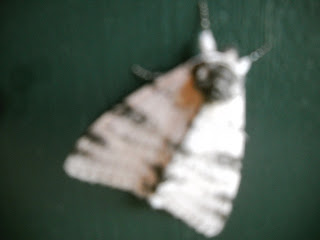 |
| FALL WEBWORM TENTS.. |
 |
| ...CLOSE UP... |
 |
| ...ADULT MOTH... |
 |
| ....CATERPILLAR THAT FEEDS INSIDE THE WEB |
 |
| MYSTERY MOTH FROM FOUR YEARS AGO |
Wednesday, 8:00 AM. 59 degrees F at the ferry dock, 55 on the back porch (up from 50 an hour ago). Wind SW, very light. The sky is clear, the humidity 83% and the barometer is beginning to fall, now at 30.09". It is a cool, pleasant morning.
The fall webworms are caterpillars of the species Hyphantria cunea, that feed on apple and other, mostly hardwoods trees, while protected inside a silken web that they spin. They are one of the first signs of approaching fall.
There are several quite similar races of these insects, and if the season is long enough there can be more than one generation which feeds on tree foliage. The adult of the aforementioned species is a white moth about an inch-and-a-half in length. The insects overwinter in the pupal stage, in leaf litter.
Like the tent caterpillars that appear in spring, they do little real damage to their host trees, other than causing them to be unsightly.
The adult moth is a rather large, quite beautiful white moth with small black spots. Several years ago I found a beautiful moth on a door screen, but did not know what it was at the time. I think now that it was a species of fall webworm.
The spring tent caterpillars feed under silken"tents" as well, but the webbing is located at the crotches of young branches, the "worms"emerging to feed on host foliage and retreating to their webs for safety.
The fall webworms feed within their webbing, which encompasses terminal branches and leaves.
The easiest and most environmentally neutral control of both tent caterpillars and fall webworms is to cut out the branches and foliage covered by the tent or web and burn or bury them. Insecticides are hard to use on these pests because they are so well protected. If one is not squeamish they are also easy to destroy by by crushing them by hand inside their webs, if they are within reach. The insects overwinter in the leaf litter in the pupal stage, so fall cleanup is helpful.











No comments:
Post a Comment